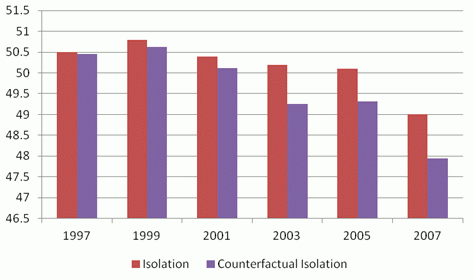A recent report of the Manhattan Institute written by Edward Glaeser and Jacob Vigdor, based on results from the 2010 US Census, documents that the downward trend in racial segregation initiated in the 1970s has continued in the first decade of 21st century (Glaeser and Vigdor2012). Standard measures of segregation, such as the isolation index that captures the overall exposure of one racial group to the others, indicate that segregation in the US has now regressed to levels observed in the 1920s, an era preceding the formation of the large black ghettos.
While the authors observe that the decline of segregation has been widespread across US metropolitan areas, they also suggest that the pre-crisis mortgage credit boom, characterised by the easing of credit standards for low-income and minority households might explained some of the last decade decline in segregation: “The extension of mortgage credit also appears to have encouraged suburban integration; the list of cities with the largest declines in segregation since 2000 includes several caught up in the subprime housing bubble during the same period”.
The hypothesis of a positive link between subprime lending and the reduction on segregation could have potentially large policy implications. As Glaeser and Vigdor indicate: “Access to credit has fostered mobility. At a time when proposed regulations threaten to eliminate the market for lending to marginal borrowers, it is important to recognise that there are costs and benefits associated with tightening credit standards”.
In a recent CEPR working paper (Ouazad and Ranciere 2011), we focus both empirically and theoretically on the relationship between credit standards and segregation. The theoretical contribution of the paper is based on a standard neighbourhood-choice model augmented with credit constraints. The probability for households to obtain a mortgage depends on their debt-to-income ratio. An easing of credit standard relaxes the relationship between the ratio of debt to income and the probability of mortgage origination. The first effect is a partial equilibrium effect. Prices being held constant, minorities who have, on average, a lower income, are now more likely to move to more expansive neighbourhoods. This is more or less what Glaeser and Vigdor have in mind when they write: “The easing of credit standards in the early part of the decade permitted many moderate-income African-American families access to neighbourhoods that would have otherwise been out of their financial reach”.
But this is not the end of story. There is also a general equilibrium effect. Richer households can also borrow more, meaning they have more financial means to outbid poorer household in desirable neighbourhood. The corresponding price increase can have the consequence of pricing minorities out of many neighbourhoods despite their better access to credit. In short, a relaxation of credit standards can, in theory, lead to either an increase or a decline in urban segregation.
Turning to the data, we compiled nearly all mortgage originations and applications during the 1995–2006 credit boom, and estimated the lending standards in each of the 366 metropolitan areas of the United States – this includes the largest metro areas such as Los Angeles and New York. Two dimensions of lending standards change dramatically during the boom:
- First, mortgage lenders tended to give loans with higher leverages – even conditional on house prices. Indeed, between 1995 and 2006, the median loan-to-income ratio jumped from 2 to 2.4 for whites, from 2.2 to 2.8 for Hispanics, and 2.1 to 2.65 for African Americans. Hispanics enjoyed a higher leverage than African Americans despite the higher average income of Hispanics.
- Second, lenders originated more and more ‘low-documentation’ loans, ie loans where the applicant’s income could not be documented or where the lenders did not require income to be filled on the application. The fraction of mortgage applications with missing income grew from 2% to about 7% between 1995 and 2006.
We also gathered the annual racial demographics of all public schools in the United States during the credit boom. A robust finding emerges: larger increases in the median loan-to-income ratio of the metro area, and/or larger increases in the number of low-documentation loans slowed down the secular decline of racial segregation across schools. Figure 1 is based on our regression estimates and compares the actual trend in segregation, measured by isolation of black students, and the counterfactual trend that would have prevailed without the relaxation of lending standards.
Figure 1. Actual isolation and counterfactual isolation of black students
Note: The isolation is the fraction of black peers for an average black student. The counterfactual isolation is the isolation that would have been measured had there been no change in the loan-to-income ratio and no increase in the fraction of low-documentation loans. The standard error on the counterfactual isolation is 0.6 in 2007, and 0.08 in 1997. Source: The authors’ own estimations from “Credit Standards and Segregation”, CEPR Discussion Paper 8300, Figure 9.
In general, Hispanic migrations have increased the exposure of black and white students to Hispanic peers. However, Hispanic families have used the easier access to credit to buy houses in predominantly Hispanic neighbourhoods with the consequence of enrolling their children in schools with fewer black peers, and more Hispanic and white peers. We estimate that, because of the credit boom, black students in 2006 had 2% fewer Hispanic peers; that is about 18 fewer Hispanic students. Results also suggest that more lenient lending standards allowed Hispanic families to cross school district boundaries: the credit boom gave Hispanic families the means to move to school districts with a lower fraction of black students. The growth of missing-income mortgage originations, from 1.5% to 5.4% of all mortgage originations, allowed Hispanic students to move to school districts with about 1,600 fewer black students.
Credit markets enabled a substantial fraction of Hispanic families to live in neighbourhoods with fewer black families, even though a substantial fraction of black families were moving to more racially integrated areas. The net effect is that credit markets increased racial segregation. Moreover, the nationwide magnitude of the effects of the credit markets on segregation is larger than what active racial integration plans have achieved. Reber (2005) finds strong effects of court-ordered desegregation plans, but these were implemented in only 108 school districts over the 1961 to 1986 period. That is less than 1% of all school districts, during one of the most active desegregation periods. In contrast, banks’ lending standards impact families’ relocation decisions nationwide, and allow them to cross school district borders, thus potentially escaping the integrative effects of desegregation plans.
All in all, credit markets cannot prevent families from experiencing the consequences of declining racial segregation, as Edward Glaeser and Jacob Vigdor showed in their Manhattan Institute Report. But the relaxation of credit standards has led to a substantial fraction of families enrolling their children in schools with fewer minority peers, reducing at the margin the overall decline of segregation.
References
Glaeser, Edward and Jacob Vigdor (2012), “The End of the Segregated Century: Racial Separation in America's Neighborhoods, 1890-2010”, Manhattan Institute, Civic Report 66.
Ouazad, Amine and Romain Ranciere (2011), “Credit Standards and Segregation”, CEPR Discussion Paper 8300.
Reber, S. J. (2005), “Court-ordered desegregation: Successes and failures integrating American schools since Brown versus Board of Education”, Journal of Human Resources 40(3) 559–90.



